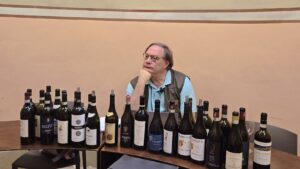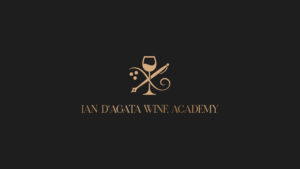Can the big wine in the sky truly surprise you? Inside a sealed aircraft cabin, with thin air and dulled senses, many wines that shine on the ground seem to lose their color at altitude. Aromas and flavours may differ as well, to a greater or lesser degree. But for me, even at thirty thousand feet, a good glass of wine still deserves to be taken seriously, and can be recognized as such. And so, I began taking detailed tasting notes on what I was drinking during several recent journeys up high in the air, documenting the wines I tasted -some delightful, some disappointing, but all memorable in one way or another. Because even at cruising altitude, I believe every glass has something to say.

The wines in this report
Please note that the following wines were all tasted in business and first-class lounges or in-flight. So this specific report does not address wines available in economy class.
The Welcome Ritual: Champagne at Takeoff
The first glass of Champagne offered after boarding is rarely the best, but it carries a kind of ritual significance. Like the ringing of a departure bell, wherever you’re headed, once the bubbles rise, you feel yourself beginning to relax.
Veuve Clicquot Brut Yellow Label NV (Champagne) — Emirates (In-flight)
Toasty apple, citrus peel, and brioche on the nose. The fruit is round, the residual sugar slightly higher than expected, the acidity soft. The mousse is gentle. At altitude, it shows as particularly approachable—comfortable and easy to drink.
Moët & Chandon Brut Impérial NV (Champagne) — Emirates (In-flight)
Lemon zest, green apple, and white flower aromas come through with a lean structure. Brisk acidity and lively bubbles, but the palate feels skeletal. In the dry, cold cabin air, it comes off as perhaps a bit too angular.
Champagne Thiénot Brut NV (Champagne) — Air France (In-flight)
Citrus, white flowers, and a touch of creamy brioche. There’s a whisper of residual sugar that lends roundness. The acidity is clear, the bubbles fine. A balanced, modest Champagne that pairs well with in-flight cuisine.
Champagne Drappier Premier Cru Brut NV (Champagne) — ANA (In-flight)
Notes of grapefruit zest, white peach, and stone fruit, with a hint of creaminess. Bright, clean acidity and a touch of sweetness stretch the finish. The mousse is smooth and persistent. A wine that exceeded expectations at altitude—balanced and vivid.
Clarity Above the Clouds: High Up in the Air, the White Wines Outshine the Reds
It might just be me, but I’d say that in-flight, white wines often perform better than reds. Their clean acidity, fruit-forward freshness, and lighter structure make them more adaptable to the cabin’s low pressure and dry air. Even without ideal glassware or temperature, a well-made white can still offer comfort and clarity in the sky.
Domaine William Fèvre Chablis 2022 (Chablis) — Air France (Lounge)
Lemon zest, green apple, white flowers, and a fine chalky minerality. The nose is precise, and the acidity is vivid and well-integrated. Light-bodied but not hollow, with a clean backbone and a subtle honeyed note on the finish. A top-quality basic Chablis.
Domaine William Fèvre Chablis 2022 (Chablis) — Air France (In-flight)
The same wine on board felt muted—aromas pulled back, acidity sharper, fruit diluted. Structure loose. A clear case of how altitude can shift perception.
Planeta Chardonnay 2021 (Sicilia DOC) — Emirates (In-flight)
Ripe peach, acacia honey, baked pear, and a touch of lollipop warmth. Surprisingly well-structured thanks to chalky soil lending vibrant acidity. Full fruit without being heavy. Balanced, expressive, and a lovely surprise from a warm region.

Tilia Chardonnay 2017 (Mendoza) — Emirates (Lounge)
Papaya, pineapple, white peach, with restrained oak. Clean and direct fruit expression, medium acidity, straightforward structure. Nothing complex, but highly serviceable—especially with Chinese food.
Louis Latour Meursault 1er Cru Château de Blagny 2018 (Meursault) — Emirates (In-flight)
Roasted hazelnut, baked apple, and creamy butter aromas open strongly. The palate is round, with moderate acidity and decent mid-palate weight. However, it lacks tension and finishes short. A solid, if unremarkable, premier cru.
Santa Margherita Vino Spumante Rosé Brut NV (Italy) — Lufthansa (VIP Lounge)
Strawberry, raspberry, citrus peel, and rose petal on the nose. Fresh, clean fruit. The mousse is soft, acidity modest. An easy-drinking, uncomplicated rosé sparkler, but one that feels thoughtfully made.
Juliusspital Würzburger Stein Riesling Trocken (2023 Franken) — Lufthansa (VIP Lounge)
Aromas of green apple, white peach, lemon zest, and wet stone. The acidity is brisk, the body lean but defined. Saline minerality on the finish. One of the most complete Rieslings of the trip—precise, bright, quietly structured.

Dassai Blue Type 35 (No vintage, Hudson Valley, New York) — ANA (New York to Tokyo flight)
This sake was served on a night flight from New York to Tokyo. Its origins are distinctive—it’s made not in Japan, but by Asahi Shuzo at their brewery in New York’s Hudson Valley, using locally grown Yamadanishiki rice.
The nose is pure and gentle, with aromas of white peach, honeydew, warm rice steam, and a hint of jasmine and stone. The palate is smooth and feather-light, with minimal sweetness and soft, rounded rice flavors. Acidity is subtle but provides structure. The finish is clean, slightly mineral, and lingers with clarity.
In a flight filled with wines, this was the quietest but most memorable glass. Refined, restrained, and deeply calming.
Red Wines at Altitude — A Rollercoaster of Expression
Compared to white wines, red wines struggle more at altitude. Their complexity, structure, and subtle aromatics are easily muted by cabin pressure, dry air, and limited breathing time. Some bottles stayed silent; others managed to speak, quietly but clearly, and not always so well. Compared to the white wines, the highs and lows were more dramatic—and sometimes more revealing.
Carruades de Lafite 2006 (Pauillac) — Emirates (Lounge)
Leather, blackcurrant, dried rose, graphite, and cedar. The bouquet is layered and evolved, classic Pauillac with earthy depth. The palate is medium-plus in body, with supple tannins, mellow acidity, and a long, smoky, slightly truffled finish. A wine of calm maturity and quiet charisma.
Château Léoville Poyferré 2018 (Saint-Julien) — Air France (In-flight)
Cassis, black cherry, cedar, cocoa, and graphite on the nose. Dense but balanced fruit. Tannins are finely woven, structure solid, acidity in check. Cool, composed, and confidently Left Bank.
Château Ripeau 2010 (Saint-Émilion Grand Cru Classé) — Emirates (Lounge)
Blackberry, violet, coffee bean, licorice, and a touch of mocha. Full-bodied with firm, youthful tannins, moderate acidity, and strong structure. Some green herbal tones in the finish. Still youthful—could use more time in bottle.

Orma Toscana IGT 2010 (Tuscany) — Emirates (In-flight)
Blackberry, plum, mocha, violet, and vanilla notes emerge clearly. Full-bodied, polished tannins, balanced acidity. Rich fruit but held in check—no excessive ripeness. There’s both elegance and strength here. A solid example of a modern SuperTuscan, expressive yet restrained.
Albert Bichot Gevrey-Chambertin “La Justice” 2014 (Gevrey-Chambertin) — Emirates (In-flight)
Light cherry, dried rose, and damp soil on the nose, but overall quite muted. The palate is thin, soft in acidity, and lacking tension. A wine that seemed to shut down completely in the cabin—more a whisper than a voice.

M. Chapoutier Bila-Haut Rouge 2020 (Côtes du Roussillon Villages) — Air France (In-flight)
Violet, black pepper, and licorice notes leap from the glass, but the palate fails to follow through. Flavors are hollow, texture is loose, finish is short. An energetic overture with no second act.
Epilogue: One Glass, Half a Journey
Wine served on a plane is rarely the best. But it still carries weight. Up here, I find myself remembering the aroma of a wine slowly rising, sometimes from a plastic cup which admittedly, is less than an ideal way of tasting wine. However, there are lessons to be learned. I notice how a touch of residual sugar lingers just a little longer in my mouth than it would on the ground. I recall bottles that dazzled me at sea level but turned silent in the air. Taste, pressure, time, mood—they all change. And in the thin air above thirty thousand feet, wine takes on a human character: sometimes extroverted, sometimes reserved, sometimes stubborn. I began to rethink what “good” wine means. It’s not about ratings, not about vintage charts or regional prestige. It’s about that one moment during travel when a sip of wine makes you stop and pay attention—when you actually want to finish the glass, not out of thirst or habit, but because it makes sense. Some of these wines delighted me, others disappointed me. But all of them were part of the journey. They are the flavor notes behind each flight number, the small rituals that anchored me between fatigue and jet lag.
Therefore, I took them seriously. They traveled with me, drifting through clouds and time zones, quiet witnesses to motion and memory. I don’t what wines I’ll meet on my next flight, but I do know this: as long as there’s one good glass, the journey will always be worth it. Or at the very least, worth more than it would have been without wine to keep me company (and for that matter, everybody else on board so inclined).



